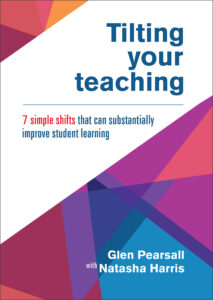
Q: In the U.S. we hear a lot about “reforming” education, or even “disrupting” it. Is this too grandiose?
A: It is easy in teaching to change your mind. What’s harder is to change habits. Inevitably, strategic change in education takes place at the systems level, but how to get the most out of these changes is actually about changing your everyday classroom practice. Sometimes focusing on big-picture reforms gets in the way of embedding these habits.
In my work, I often see reform initiatives fail at the school level not because of a lack of will or effort but because teachers have small skill gaps that get in the way of putting new approaches into action. For example, there might be a new emphasis at your school on ensuring all students have a voice, but if you haven’t mastered using extended wait times, then many of the students you want to hear from might never speak up.
Richard Elmore famously said schools change “routinely” and “promiscuously.” Indeed, sometimes schools are so reform-minded that they miss opportunities to refine teaching and learning through small incremental change. If I’m a busy teacher, then making a slight adjustment to what I do in a lesson is much easier than instituting a radical change of approach. But stack up enough of these subtle adjustments and I can substantially improve my teaching without having to feel overworked or overwhelmed.
Q: What does coaching teachers have in common with coaching athletes?
A: Like coaches of professional athletes, teacher coaches focus on technique. Now this is not always the image of coaches in popular culture—think of the sports coach in a movie exhorting his tired team to dig deep and produce one heroic final effort for the last play of the game. If you watch actual elite sports coaches in action, though, what they spend most of their time doing is talking about approach, about tactics and technique. Teachers don’t need a coach to tell them to try harder—teachers already work more than hard enough—what they need is a sounding board, someone who can help them identify and explore the sub-skills for mastering a technique and then offer feedback as the teacher hones their craft.
This is another telling similarity between coaching teachers and athletes: Great coaches believe everyone can improve. Whether you are a five-year-old picking up a basketball for the first time or the best player in the NBA, there is no sense that you are beyond coaching. Similarly, teaching is not a job that you are ever “finished.” There is always room to get better and a coach is an important part of that process. I used to run a program for teachers in crisis while at the same time running workshops for elite-performing teachers. The structure for both courses was identical—we would identify what the teacher wanted to work on next and then help reach that goal one subtle improvement at a time.
Whether coaching athletes or teachers, an effective coach believes that everyone has the capacity to learn and knows the steps to reach this goal.
Q: There are some pretty harrowing anecdotes in Tilting Your Teaching, like the kid who picked a fight with the teacher about whether he’d thrown a rock or a stone. Can some of the small changes in technique, what you’ve called the Simple Shifts, actually produce more peaceful, productive classrooms?
A: When you face a big challenge in your class—for example a student who is being aggressive and oppositional—it can be hard to believe that the answer requires only small changes of practice. I started to use video in my work so that I wasn’t just telling teachers that this can work, but actually showing them.
When teachers are reviewing their lessons in video coaching, they often spot “sliding door” moments when a subtle shift in their body language or slightly different phrasing would have defused a situation or stopped off-task behavior happening altogether. Moreover, when teachers see other educators (particularly in their own school) use a strategy successfully, they are usually quick to take up that practice.
Imagine you’re a teacher who finds themselves constantly getting entangled in combative arguments with particular students. It may be that a review of your school’s discipline policy will help this situation. However, so will being taught a set of pivot phrases (“That’s not the issue right now” or “I welcome feedback—just not at the start of the lesson”) for pivoting around student resistance and back to what matters: the learning.
Many of the schools I work with make video compilations of these Simple Shifts being put into action so they can be used as a video toolkit of effective practice to share amongst their staff. Perhaps even more powerfully, some schools use before-and-after videos to demonstrate the concrete improvement that Simple Shifts have made at their schools.
If you want more peaceful and productive learning environment, then examining minutiae of teaching practice is a quick and effective way to get better outcomes for student and teacher alike.
Q: You speak convincingly of the need for teachers to collect informal data on their own performance. Is it possible to make the Simple Shifts without the data-gathering?
A: The strategies explored in Tilting Your Teaching have a long and established record of helping improve teacher practice in a wide array of schools and school systems. If you just implement some of these Simple Shifts you will, with a bit of trial and error, see results in your classroom. However, if you want to maximize that effect, you can use the micro-data tools featured in the book.
The best analogy here is the Fitbit. If I want to exercise more, I could schedule more exercise sessions. Using a Fitbit that counts my steps helps make this intention an everyday habit. Wearing a Fitbit means that I have a constant reminder that prompts me to be more active daily and measures my efforts to meet that goal.
The micro-data tools featured in the book operate in the same way. We call them micro-data tools to distinguish them from all the other data we collect as schools and teachers. Most of that data—system-level assessments, diagnostic tests, end-of-year exams—is collected annually or over term or semester cycles. This information might be important for measuring student growth or school and district performance, but it’s not as useful if you’re trying to establish a new teaching routine or skill.
By contrast, micro-data tools focus on small but crucial aspects of your practice over a single lesson or activity, such as the length of your wait time or the number of opportunities you give students to respond. They operate as a habit tracker: a feedback loop that helps keep you more conscious of these crucial adjustments of practice.
Sometimes recording data can seem like yet another thing that teachers have to do—an action far removed from the business of everyday teaching. The micro-data tools in this book do the opposite: They concentrate your attention on what matters most in the classroom and ensure that the process of skill acquisition takes up less of your teaching time.
Q: Two of the Simple Shifts in your book explore how to encourage student voice, while two others deal with outspoken or off-task behavior. How can teachers honor students’ rights to expression while still keeping the focus on learning?
A: The right to expression and the need for orderly classrooms are not competing goals but a single one: We want students to be active and responsible participants in an inclusive classroom.
This is why the Simple Shifts don’t just concentrate on dealing with off-task behavior but with fostering active and engaged learners. Honing our questioning technique to ensure every student is involved in class discussion, establishing classroom routines to minimize distraction and maximize learning time, and refining our feedback techniques so that we can meet each student at their precise point of need, all help students to be responsible classmates.
I always tell the teachers I’m coaching that if you want to foster a cooperative learning environment, it is not what you say “no” to but what you say “yes” to that counts. Our goal is to engage students so that they are eager to learn and less likely to exhibit off-task behaviors. We don’t want our students to be merely compliant—we want them to be active class members who are aware of all the rights and responsibilities that that entails.
Q: What about online teaching, which adds a new layer of challenge to classroom management. Do you have any tips?
A: The Golden Rule of teaching is relationship first, task second. In online learning environments much of the informal interaction that helps build those relationships—the warm greeting at the door, the incidental conversations about a student’s interest, the affirming smile—is stripped away, and interactions can become too exclusively task-focused. If you are teaching online you need to make a conscious effort to make relationship-building part of your program: Take the time to connect with your students. Build space in your curriculum to routinely check on their welfare. Seek out feedback to evaluate how are they faring during remote learning and assess their levels of engagement.
During the switch to online learning in the Covid-19 crisis, most of the teachers I’ve worked with have made a point of giving their students reminders about what is appropriate conduct when online. This, of course, is important, but making a conscious effort to maintain your relationships with your students is just as important—and in the tumult of the current environment that is easy to skip. Dedicating some time to doing this might feel hard to juggle in the short term, but in the long term, improving the strength of your relationships with your students will make teaching and learning online less stressful and more productive.

